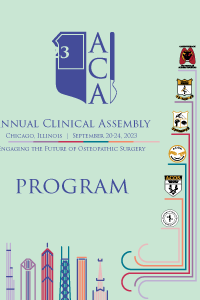ACOS 2023 Annual Clinical Assembly
General Surgery
Decreased Hospital Length of Stay and Post-Operative Opioid Use After Administration of a Novel Multimodal Transversus Abdominis Plane Block During Robotic Abdominal Wall Reconstruction

Alexandra C. Skoczek, MPH, MS-IV (she/her/hers)
Medical Student
Edward Via College of Osteopathic Medicine - Auburn
Edward Via College of Osteopathic Medicine - AuburnDisclosure(s): No financial relationships to disclose
Member Speaker(s)
Learning Objectives:
- List the components of a multimodal TAP block compared to a traditional TAP block.
- Report the difference in opioid usage following robotic abdominal wall reconstruction in patients who recieve a multimodal TAP block compared to patients who recieve no TAP block.
- Summarize the difference in hospital length of stay following robotic abdominal wall reconstruction in patients who recieve a multimodal TAP block compared to patients who recieve no TAP block.
Methods or Case Description: A retrospective review of medical records for patients who underwent elective robotic ventral hernia repair with the transversus abdominis release (TAR) method by a single surgeon was conducted. Postoperative hospital LOS and opioid usage data for patients who had the multi-modal TAP block was compared with those who did not receive the TAP block.
Outcomes:
A total of 334 patients met the inclusion criteria for LOS analysis, 235 who received the TAP block and 109 who did not. Patients who received the TAP block had a statistically significant shorter LOS compared to patients who had no TAP block (1.09 ± 1.22 days vs. 2.53 ± 1.57 days; P< .001). 281 patients, 214 with the TAP block and 67 without the TAP block, were analyzed for postoperative opioid usage. A statistically significant fewer number of patients who had the TAP block required hydromorphone patient-controlled analgesia (PCA) pump (3.3% vs. 36%; P< .001) and oral opioids (29% vs. 78%; P< .001) postoperatively. Those with the TAP block required more use of PRN IV opioids (50% vs 10%; P< .001) however, those with the TAP block that required IV opioids required lower dosages (4.86 ± 2.62 mg vs. 10.29 ±3.90 mg; P< .001).
Conclusion: A multi-modal TAP block of ropivacaine, ketorolac, and epinephrine may represent an effective method to improve hospital LOS and postoperative opioid usage in patients undergoing robotic abdominal wall reconstruction for ventral hernia repair. Future studies aimed at comparing the traditional TAP block to the novel multimodal TAP block will be required now that initial efficacy has been demonstrated.

